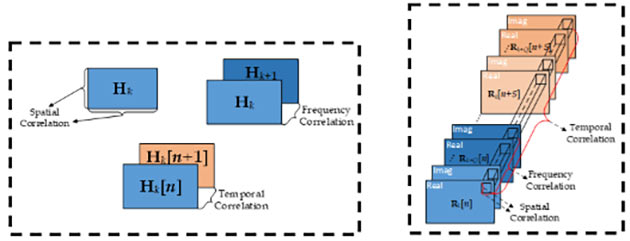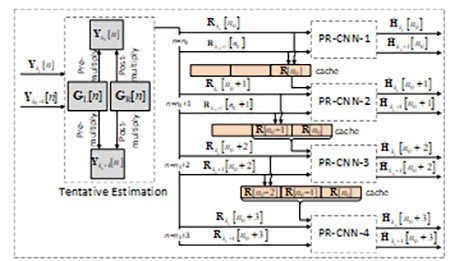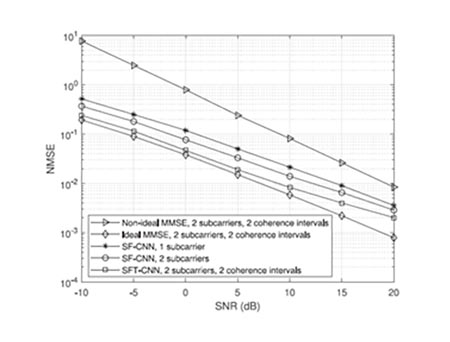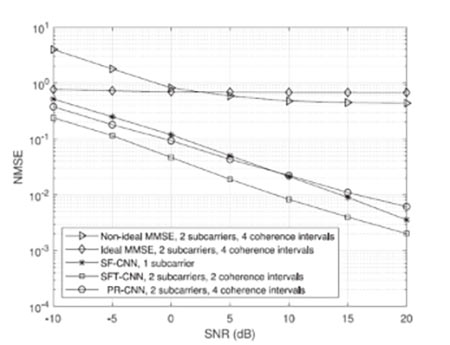
Contributed by Peihao Dong, based on the IEEEXplore® article, “Deep CNN-Based Channel Estimation for mmWave Massive MIMO Systems,” published in the IEEE Journal of Selected Topics in Signal Processing, 2019.
Introduction
Millimeter wave (mmWave) communications provide a promising solution to meet the proliferating demand for high data rate because of large bandwidth. The current “boomingly” deployed fifth generation communication system (5G) has not actually touched the dominant frequency band of mmWave and thus can hardly enjoy its merit on dramatically boosting transmission rate, which motivates us to conduct research on the ultimate implementation of mmWave communications. To cope with propagation attenuation and sparse scattering, mmWave and massive multiple-input multiple-output (MIMO) are usually orchestrated to support energy-focusing and directional transmission, which meanwhile incurs unprecedented challenges in channel estimation [1].
Why Deep Learning-Based Channel Estimation?
Multitudinous conventional channel estimation methods have been proposed based on compressive sensing, low-rank tensor decomposition, subspace estimation, and so on [2]-[4]. However, they usually rely on accurate mathematical models with the priori of channel characteristics, and thus may suffer from significant performance degradation when facing the complex and dynamic environment. In addition, the high computational complexity is incompatible with the much shorter coherence interval of mmWave channels as well as the strict requirement on communication latency. Deep learning (DL) can efficiently handle these intractable problems shriveling conventional optimization-based methods. Fig. 1 shows the comparison between the conventional channel estimators and the DL-based estimator in terms of performance, pilot overhead, processing time, and dependence of channel statistics. The comparison reveals compelling merits of the DL-based estimator and inspires us to resolve the channel estimation challenge for mmWave massive MIMO systems [5].

Figure 1. Conventional Estimators vs. DL-Based Estimator.
Capturing 3D Channel Correlation by CNN
The limited number of scatterers in the mmWave propagation environment introduce the three-dimension (3D) channel correlations, i.e., spatial, frequency, and temporal correlations among channels of different antennas, channels at different subcarriers, and channels in different coherence intervals, respectively. The 3D channel correlations are favorable for the channel estimation but can be hardly grasped by the traditional method. Thanks to the 3D convolution kernel used in convolution neural network (CNN), the helpful 3D correlation can be well captured by filtering pilot matrices of adjacent subcarriers and coherence intervals simultaneously, as shown in Fig. 2.

Figure 2. 3D channel correlations and explanation of how CNN captures them.
SFT-CNN and PR-CNN Based Channel Estimation
We have first developed a spatial-frequency-temporal CNN (SFT-CNN) based channel estimation approach, where the received pilots of multiple adjacent subcarriers in the previous and current coherence intervals are exploited simultaneously by the CNN to jointly estimate the channels in the current coherence interval. As shown in Fig. 3, the tentative estimation module receives the pilot matrices of subcarriers k0 and k0 +1 and provides coarse estimates facilitating SFT-CNN processing in each coherence interval. The inputs of SFT-CNN are tentatively estimated channels of subcarriers k0 and k0 +1 in coherence intervals n0 and n0 +1 while the outputs are estimated channels of subcarriers k0 and k0 +1 in coherence interval n0+1. The proposed SFT-CNN based estimator is scalable to number of subcarriers and coherence intervals. It achieves almost the same accuracy with the long, short-term memory CNN (LSTM-CNN) [5], but has the much lower complexity.

Figure 3. Architecture of SFT-CNN based channel estimation.
To reduce the pilot overhead caused by large-scale antenna arrays, we have then proposed the pilot-reduced CNN (PR-CNN) based channel estimation with the similar structure to SFT-CNN. Specifically, PR-CNN consists of multiple channel estimation units (CEUs), each of which groups several successive coherence intervals with gradually reduced pilot overhead. Within each CEU, pilot matrices are cumulated along with the coherence interval and are input into the corresponding sub-CNN, named PR-CNN-d, for the dth coherence interval. The PR-CNN based estimator exploits the frequency and temporal correlations to compensate the pilot reduction with the slightly increased complexity compared to SFT-CNN.

Figure 4. Architecture of PR-CNN based channel estimation.
Performance
In simulations, the channel data are generated according to the 3rd Generation Partnership Project (3GPP) TR 38.901 Release 15 channel model [7]. In Fig. 5, we compare the proposed SFT-CNN based channel estimation with other approaches. From this figure, the SFT-CNN based approach outperforms significantly in both performance and complexity at the cost of offline training. It is even very close to the ideal MMSE estimator that is quite difficult to be implemented in practical situation at the low and medium.

Figure 5. NMSE versus SNR for the SFT-CNN based channel estimation and MMSE channel estimation.

Figure 6. NMSE versus SNR for the PR-CNN based channel estimation and MMSE channel estimation.
From Fig. 6, the PR-CNN based approach achieves comparable performance to the SFT-CNN based approach, especially at the low and medium SNR, but only requires about one third of pilot overhead at the cost of complexity. This means that the additional frequency and temporal correlation has been efficiently utilized by the PR-CNN based approach to reduce the spatial pilot overhead significantly. On the contrary, both the ideal and non-ideal MMSE perform poorly even if using the same channel correlation information as the PR-CNN based approach, which reveals that the proposed approach is able to tolerate the reduction of spatial pilot overhead.
Conclusion
In this blog, we have developed the deep CNN based channel estimation approaches for mmWave massive systems. The SFT-CNN based channel estimation is first proposed to simultaneously utilize spatial, frequency, and temporal correlations. Considering the huge spatial pilot overhead caused by massive antennas, we design the PR-CNN based channel estimation to mitigate this problem. The proposed SFT-CNN based approach outperform the non-ideal MMSE estimator yet requiring lower complexity and achieve the performance very close to the ideal MMSE estimator. The PR-CNN based channel estimation is efficient to save the spatial pilot overhead significantly with minor performance loss.
References:
[1] A. L. Swindlehurst, E.Ayanoglu, P. Heydari, and F. Capolino, “Millimeter-wave massive MIMO: The next wireless revolution?" IEEE Commun. Mag., vol. 52, no. 9, pp. 56–62, Sep. 2014, doi: https://dx.doi.org/10.1109/MCOM.2014.6894453.
[2] A. Alkhateeb, O. E. Ayach, G. Leus, and R. W. Heath Jr., "Channel estimation and hybrid precoding for millimeter wave cellular systems," IEEE J. Sel. Topics Signal Process., vol. 8, no. 5, pp. 831–846, Oct. 2014, doi: https://dx.doi.org/10.1109/JSTSP.2014.2334278.
[3] Z. Gao, C. Hu, L. Dai, and Z. Wang, "Channel estimation for millimeter-wave massive MIMO with hybrid precoding over frequency-selective fading channels," IEEE Commun. Lett., vol. 20, no. 6, pp. 1259–1262, Jun. 2016, doi: https://dx.doi.org/10.1109/LCOMM.2016.2555299.
[4] Z. Zhou, J. Fang, L. Yang, H. Li, Z. Chen, and R. S. Blum, “Low-rank tensor decomposition-aided channel estimation for millimeter wave MIMO-OFDM systems," IEEE J. Sel. Areas Commun., vol. 35, no. 7, pp. 1524–1538, Jul. 2017, doi: https://dx.doi.org/10.1109/JSAC.2017.2699338.
[5] P. Dong, H. Zhang, G. Y. Li, I. Gaspar, and N. NaderiAlizadeh, “Deep CNN-based channel estimation for mmWave massive MIMO systems," IEEE J. Sel. Topics Signal Process., vol. 13, no. 5, pp. 989–1000, Sep. 2019, doi: https://dx.doi.org/10.1109/JSTSP.2019.2925975.
[6] X. Shi, Z. Chen, H. Wang, D. Y. Yeung, W. K. Wong, and W. C. Woo, "Convolutional LSTM network: A machine learning approach for precipitation nowcasting," in Proc. Neural Inf. Process. Syst., 2015, pp. 802–810.
[7] 3GPP, "5G; Study on channelmodel for frequencies from 0.5 to 100 GHz," 3rd Generation Partnership Project (3GPP), Tech. Rep. 38.901 V15.0.0, Jun. 2018.
